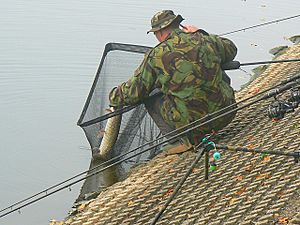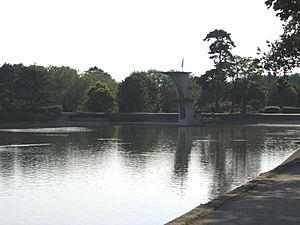Coate Water Country Park facts for kids

Coate Water is a fun country park located near Swindon, England. It's about 5 kilometers (3 miles) southeast of the town. The park is named after its main feature: a big lake! This lake was first created to provide water for an old canal.
The large lake was built in 1822. It covers about 70 acres (28 hectares). Workers made it by changing the path of the River Cole. Its main job was to supply water for the Wilts & Berks Canal. Coate Water became part of Swindon in 1928.
In 1914, the canal was no longer used. So, Coate Water became a fun park for everyone. They added changing rooms and a wooden diving board. In 1935, a new, tall concrete diving board was built. It's 33 feet (10 meters) high and looks very cool, like Art Deco style! Even though you can't swim in the lake since 1958, this diving board is special. It was protected in 2013 because of its history and design. Today, Coate Water Country Park is a great place for both fun activities and seeing nature.
Contents
A Look Back in Time: Archaeology
The area around Coate Water has a very long history. People have lived here for over 7,000 years! We know this from old clues they left behind. These clues come from different time periods. These include the Stone Age, Bronze Age, Iron Age, Roman times, and the Middle Ages.
Ancient Discoveries
The oldest known ancient sites at Coate are stone circles. There are also burial mounds from the Bronze Age along Day House Lane. More Bronze Age burials and other old earthworks have been found nearby. Scientists have also found many ancient flint tools. These tools show that people lived here during the Mesolithic period (Middle Stone Age).
In the past, six stone circles were recorded in the Coate area. They might have been connected by paths of large sarsen stones. It's thought that parts of one stone circle might still be at the bottom of Coate Water lake! Other important finds include the Coate Mound. This mound was dug up a long time ago.
Later Settlements
Other ancient finds are located south of Coate, near Badbury Wick. These include signs of farming from the Middle Bronze Age. There was also a settlement from the Mid-late Bronze Age. Later, people built simple homes during the Iron Age. A small Roman settlement was also found. There's even a village from the Middle Ages that is now empty.
Nature and Wildlife: Ecology
Coate Water is a very important place for nature. A large part of the lake and its edges is a special protected area. It's called a Site of Special Scientific Interest (SSSI). This means it's important for its wildlife, especially for the birds that breed here. Part of the site is also a local nature reserve.
Amazing Birds of Coate Water
Coate Water is a fantastic spot for birdwatching. Many rare birds for the Wiltshire area have been seen here. Here are some of them:
- Bearded tit – a pair seen in October 1982
- Black-crowned night heron – adults seen in April 1978 and May 1990
- Black-throated diver – an adult seen in February 1978
- Black Swan - one seen in February 2018
- Eurasian spoonbill – two adults seen in April 1978
- European shag – one seen in September 1993
- Grey phalarope – two young birds seen in October 1987
- Little auk – one seen in January 1984
- Northern fulmar – one seen in June 1978
- Purple heron – a young bird seen in May 1981
- Red-necked grebe – an adult seen in March/April 1995
- Red-throated diver – a young bird seen in March 1979
- Ring-necked duck – a young male seen in January 1998
- Rock pipit – one seen in March 1976
- Slavonian grebe – one seen in January 1982
- Warblers:
- Barred warbler – one seen in September 1980
- Savi's warbler – one seen in May 1965
- Yellow-browed warbler – one seen in September 1988
Fun Things to Do: Activities
Coate Water offers several fun activities for visitors.
- The Swindon Rowing Club is based at the lake.
- The Coate Water Sailing Trust also uses the lake for sailing.
- The North Wilts Model Engineering Society has a cool miniature railway. It has about one mile of track. You can ride on small trains here!
Coate Water in Stories: In Fiction
The famous author Richard Jefferies (1848–1887) was born in Coate village. This village is a short distance northeast of Coate Water. His home is now a museum. The "New Sea" in his popular Bevis books was based on Coate Water.
Images for kids
-
The Art Deco diving board at Coate Water Country Park.




